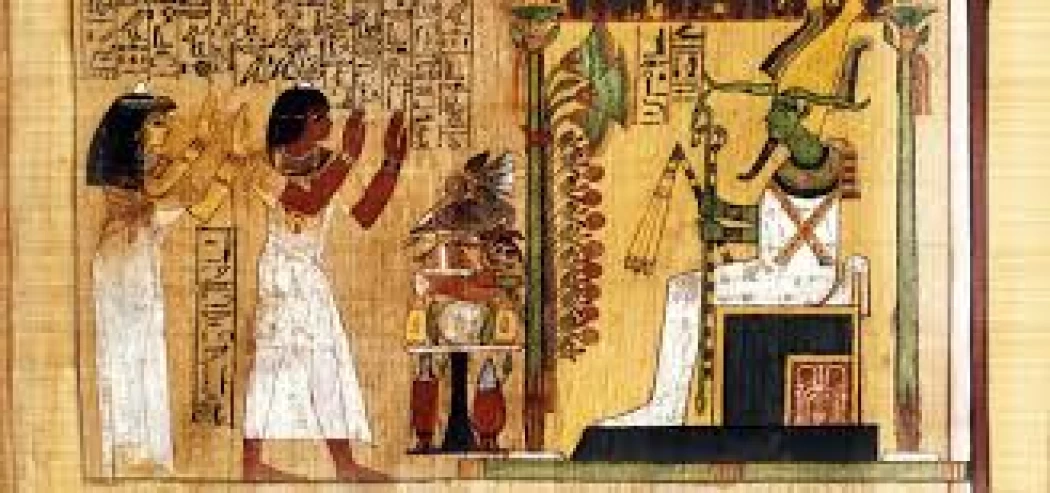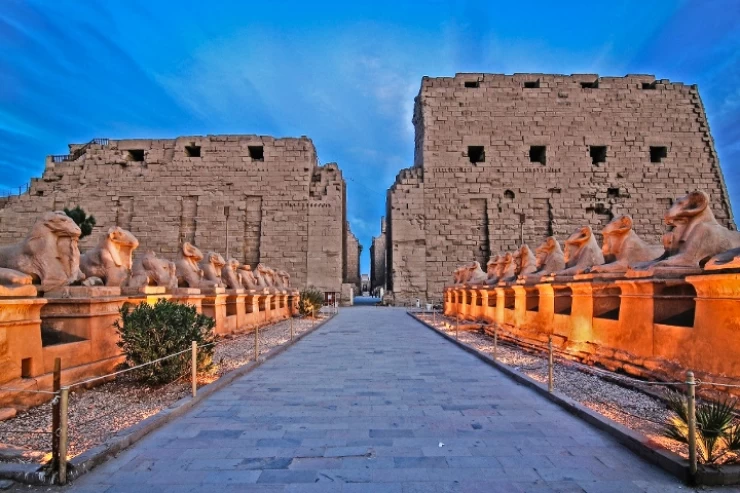
O Livro dos Mortos | Ancient Egyptian Funerary Text
Dentro havia textos funerários de vários tipos, tanto fórmulas mágico-religiosas quanto histórias, com a ajuda das quais o falecido poderia superar as inúmeras provações que enfrentaria no longo e sinuoso caminho que o levou à presença de Osíris. Os textos, portanto, o teriam ajudado tanto a alcançar o deus da morte sem problemas especiais, quanto a preparar o chamado testemunho de sua vida terrena, cujo julgamento pertencia a Osíris.
O Livro dos mortos tomou várias formas ao longo do tempo. Inicialmente, de fato, fórmulas e histórias foram gravadas nas paredes da tumba, apenas para serem gravadas diretamente no sarcófago. Com o tempo e até a décima oitava dinastia (1543-1292 A. C.), O Livro dos mortos voltou a mudar de forma: os textos fúnebres foram transferidos para papiro, depois fechados em um sarcófago junto com o falecido e todos aqueles objetos que poderiam ser úteis em sua última viagem.
Essas fórmulas mágicas colocadas em tumbas, segundo as crenças, protegiam e ajudavam os falecidos no submundo, e incluem hinos ao deus Amon Re, o deus do sol. Podemos ver descrições de feitiços nas passagens e paredes de tumbas, nos invólucros de múmias e até mesmo dentro da máscara dourada do rei Tutancâmon.
O Livro dos mortos apareceu pela primeira vez no novo reino, mas seu texto evoluiu de uma longa história de escrita funerária mágica. O mais antigo deles, os textos das pirâmides, eram acessíveis apenas aos egípcios. Em seguida, eles evoluíram para textos de caixão - uma versão modificada dos textos da pirâmide - que foram escritos em caixões e incluídos nos túmulos de pessoas não reais, como egípcios ricos e representantes da elite.
Osíris era o deus da ressurreição, e ré era o deus do sol, uma estrela no Livro dos mortos. Então 42 deuses adicionais se voltam para o juiz. Embora o texto em si varie em conteúdo e ordem, a história geralmente é dividida em quatro seções principais: o falecido entra no submundo e recupera os poderes físicos dos vivos, o falecido ressuscita e se junta a Re para se levantar como o sol todos os dias, ele viaja pelo céu antes do julgamento no submundo dos deuses e, finalmente, encontra uma alma.
Viaje ao Egito para visitar templos e pirâmides egípcias e aprender mais sobre a mitologia e centenas de deuses adorados pelos faraós, que eram muito parecidos com os humanos, amavam e odiavam, sentiam ciúmes, lutavam e morriam durante um mito incrível cheio de alegria, eventos ativos e dramáticos que inspiraram cineastas e produtores modernos a criar filmes mundialmente famosos sobre a grandeza dos Faraós e dos deuses que adoravam. Reserve alguns dias para visitar Abidos, Gizé, Luxor, Aswan para ver os túmulos dos faraós decorados com cenas muito claras, detalhadas e lindamente pintadas de várias divindades do antigo Egito, bem como muitos outros lugares, cidades, aventuras e atividades no Cairo, você pode tentar e reservar um dos nossos passeios ao Egito e Egito pacotes turísticos muitos grupos privados com um guia Cairo Day tours do aeroporto e Egito day tours para explorar a capital do Egito, Cairo você pode conferir muitos itinerários do Egito ou ir em um dos nossos passeios de um dia inteiro no Cairo, como:
- Rotas turísticas no Egito / Rotas no Egito.
- Passeios para Aswan / excursões para Aswan / passeios de um dia para Aswan | passeios turísticos para Aswan.
Inside were funerary texts of various kinds, both magico-religious formulas and stories, with the help of which the deceased could overcome the countless trials that he would face on the long and winding path that led him to the presence of Osiris. The texts, therefore, would have helped him both to reach the god of death without any special problems, and to prepare the so-called testimony of his earthly life, the trial of which belonged to Osiris.
The Book of the Dead has taken various forms over time. Initially, indeed, formulas and stories were engraved on the walls of the tomb, only to be engraved directly on the sarcophagus. Over time and until the eighteenth dynasty (1543-1292 BC), the book of the dead changed its form again: the funeral texts were transferred to papyrus, then closed in a sarcophagus along with the deceased and all those objects that could be useful in his last journey.
These magical formulas placed in tombs, according to beliefs, protected and helped the deceased in the underworld, and they include hymns to the god Amun Re, the god of the sun. We can see descriptions of spells on the passages and walls of tombs, on the wrappers of mummies and even inside the golden mask of King Tutankhamun.
The Book of the Dead first appeared in the New Kingdom, but its text evolved from a long history of magical funeral writing. The most ancient of them, the Pyramid Texts, were accessible only to the Egyptians. Then they evolved to Coffin Texts - a modified version of the Pyramid Texts - which were written on coffins and included in the tombs of non-royal persons, such as rich Egyptians and representatives of the elite.
As for the history of the writing of the Book of the Dead, the Pharaohs wrote down the Book of the Dead during the era of the construction of the Great Pyramid, and a copy of it is still preserved in the British Museum. It contains invocations to the gods, hymns, and prayers. Then there is a description of the reckoning that the souls of the dead encounter in the afterlife and the punishment and reward that befalls them.
The Pharaohs built huge temples in addition to tombs that were no less magnificent and luxurious, as they believed in resurrection and the return of the soul, which they depicted in two close images, "Ka" or "Ba." They were also keen to place all the things related to the deceased, including food, jewelry, and everything he loved in his life, with him in his tomb, where the soul of the deceased could eat and drink from it when it returned to the body, and before seeking the afterlife.
The ancient Egyptians knew religious literature since the dawn of history, and their holy books varied, most of which were about death and the afterlife. Their books usually contained a group of religious texts that expressed the Egyptians' perception of the life of the dead in the afterlife, and included a group of spells that were recited when preparing the body for burial.
Perhaps the ancient Pharaohs amazed the world with the diversity of these texts, and their abundance of ancient religious spells and literature, which remained an icon no less important than the remaining monuments from the Pharaonic eras, such as temples, royal tombs, and obelisks. Among these books' most significant works are:
Book of the Dead
Pyramid texts
The Book of Two Paths
The Guide's Book
Spell No. 125 is one of the most famous texts of the Book of the Dead. Even those unfamiliar with the book, and those unfamiliar with Egyptian mythology, know about the spell without realizing it. It is the incantation describing the trial of the deceased's heart in the Hall of Justice by the god Osiris, and is one of the most famous known images from ancient Egypt, although the god with his scale is not actually described in the text. Given the importance of the deceased passing the test of his heart weight in order to pass into bliss, knowing what to say and how to act in the presence of Osiris, Thoth, Anubis and the forty-two judges was the most important information with which the deceased could reach the afterlife.
After death, Anubis guides the deceased to the Hall of Justice (also known as the Hall of Two Truths), where the deceased will make the Confession of Absolution (also known as the Declaration of Innocence). This Confession of Absolution was a list of forty-two sins that the individual could honestly deny never to commit. Once made, Osiris, Thoth, Anubis, and the Forty-Two Judges consulted.
If the confession was accepted, the deceased's heart was weighed in a balance against the white feather of Maat, the feather of truth. If the deceased's heart was lighter than the feather of Maat, their soul passed to Heaven; if it was heavier than the feather, the heart was thrown to the ground, where it was devoured by the divine monster Ammut, and its owner's soul ceased to exist.
Spell 125 begins with an introduction to the reader (i.e., the soul of the deceased): "What to say upon arrival at the Hall of Justice"















